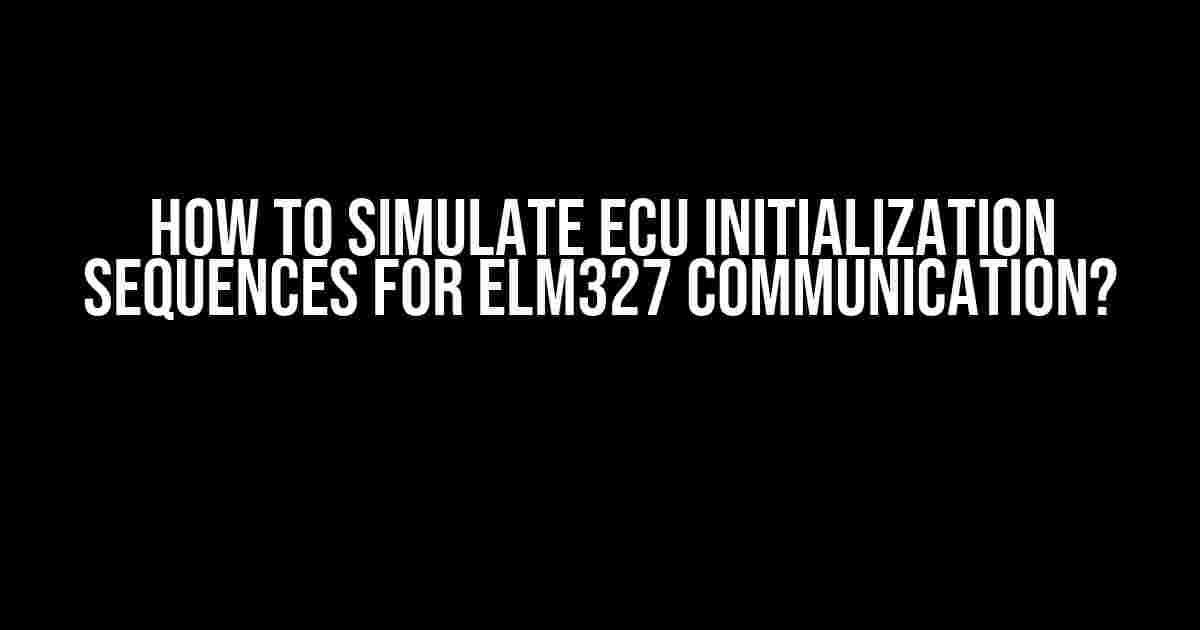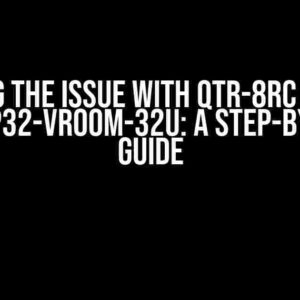Are you tired of dealing with complex ECU initialization sequences while working with ELM327 communication? Look no further! In this comprehensive guide, we’ll walk you through the process of simulating ECU initialization sequences, making your life easier and more efficient. So, buckle up and let’s dive in!
What is ECU Initialization and Why is it Important?
ECU initialization is the process by which an Engine Control Unit (ECU) is prepared to communicate with external devices, such as OBD-II scanners or ELM327 adapters. This initialization sequence involves a series of handshakes and protocol negotiations to establish a stable connection. Without proper initialization, the ECU may not respond correctly or may even refuse to communicate altogether.
Why Simulate ECU Initialization Sequences?
Simulating ECU initialization sequences can be beneficial in several scenarios:
- Development and testing: Simulating the initialization sequence can help developers test their code and ensure compatibility with various ECU types.
- Troubleshooting: By simulating the sequence, you can identify issues with the ECU or the communication protocol.
- Training and education: Simulating the initialization sequence can be a valuable learning tool for those new to ELM327 communication.
Prerequisites and Tools Needed
To simulate ECU initialization sequences, you’ll need the following:
- A computer with a serial communication software (e.g., HyperTerminal, PuTTY, or screen)
- An ELM327 adapter or an OBD-II scanner
- A compatible ECU or a simulator (e.g., ECU-Simulator or OBD-II Simulator)
- Basic understanding of serial communication protocols (e.g., UART, SAE J1850, ISO 15765-4)
Step-by-Step Guide to Simulating ECU Initialization Sequences
Step 1: Connect to the ECU or Simulator
Connect your computer to the ECU or simulator using a serial communication software. Ensure that the serial settings are correct, including the baud rate, data bits, and stop bits. For example:
Baud rate: 38400 Data bits: 8 Stop bits: 1 Parity: None
Step 2: Send the Wake-Up Command
Send the wake-up command to the ECU or simulator to initiate the initialization sequence. The wake-up command typically consists of a series of bytes, such as:
0x01 0x00 0x00 0x00 0x00 0x00 0x00 0x00
Use the serial communication software to send this command to the ECU or simulator. You may need to press Enter or send a newline character after sending the command.
Step 3: Receive the ECU Response
The ECU or simulator should respond with an acknowledgement message, indicating that it has received the wake-up command. The response may look something like this:
0x40 0x01 0x00 0x00 0x00 0x00 0x00 0x00
Take note of the response and analyze it to ensure that the ECU or simulator is responding correctly.
Step 4: Send the Initialization Command
Send the initialization command to the ECU or simulator, which typically includes the ECU type, protocol version, and other parameters. For example:
0x10 0x01 0x00 0x00 0x00 0x00 0x00 0x00
This command may vary depending on the ECU type and protocol used. Consult the ELM327 documentation or ECU specifications for the correct initialization command.
Step 5: Receive the ECU Response and Established Connection
The ECU or simulator should respond with a success message, indicating that the initialization sequence has been completed successfully. You may receive a response like this:
0x20 0x01 0x00 0x00 0x00 0x00 0x00 0x00
Congratulations! You have successfully simulated the ECU initialization sequence and established a connection with the ECU or simulator.
Troubleshooting Common Issues
During the simulation process, you may encounter some common issues:
| Issue | Solution |
|---|---|
| No response from the ECU | Check the serial settings, ensure correct baud rate, and try resetting the ECU or simulator. |
| Incorrect response from the ECU | Verify the initialization command, ensure correct ECU type and protocol, and consult the ELM327 documentation or ECU specifications. |
| Timeout errors | Adjust the serial communication software’s timeout settings or increase the delay between commands. |
Conclusion
Simulating ECU initialization sequences for ELM327 communication can be a complex task, but with the right tools and following this step-by-step guide, you’ll be able to successfully establish a connection with the ECU or simulator. Remember to consult the ELM327 documentation and ECU specifications for specific requirements, and don’t hesitate to troubleshoot common issues that may arise. Happy coding!
Additional Resources
For further information and resources, check out the following:
- ELM327 documentation: https://www.elmelectronics.com/wp-content/uploads/2019/07/ELM327-Documentation.pdf
- OBD-II and ELM327 tutorials: https://obdii.com/tutorial/
- ECU simulator software: https://ecu-simulator.com/
Frequently Asked Question
Get ready to dive into the world of ECU initialization sequences and ELM327 communication!
What is ECU initialization and why is it necessary for ELM327 communication?
ECU initialization is the process of preparing the Engine Control Unit (ECU) to communicate with external devices, such as an ELM327 interface. It’s necessary because the ECU needs to be awakened from its sleep mode and configured to transmit data to the ELM327 interface. Without initialization, the ECU won’t respond to requests from the ELM327, making communication impossible.
What are the common ECU initialization sequences used for ELM327 communication?
The most common initialization sequences used for ELM327 communication are the “AT Z” command, which resets the ECU and clears any previous commands, and the “AT SP” command, which sets the protocol to SAE J1850 PWM. Other sequences may also be required depending on the specific vehicle and ECU type.
How do I simulate ECU initialization sequences for ELM327 communication?
To simulate ECU initialization sequences, you can use a software tool that mimics the ELM327 interface, such as a Python script or a dedicated ECU simulation software. These tools can send the necessary initialization commands to the ECU, allowing you to test and debug your ELM327 communication setup.
What are some common challenges encountered when simulating ECU initialization sequences for ELM327 communication?
Common challenges include incorrect initialization sequence timing, incorrect protocol settings, and ECU timeouts due to excessive command sending. Additionally, some ECUs may require specific initialization sequences that are not well-documented, making it difficult to simulate the correct sequence.
Can I use a generic ECU initialization sequence for all vehicles, or do I need a specific sequence for each vehicle type?
While some generic sequences may work for multiple vehicles, it’s generally recommended to use a specific initialization sequence for each vehicle type. This is because different vehicles and ECUs may have unique requirements and protocols, and using a generic sequence may not ensure reliable communication.


